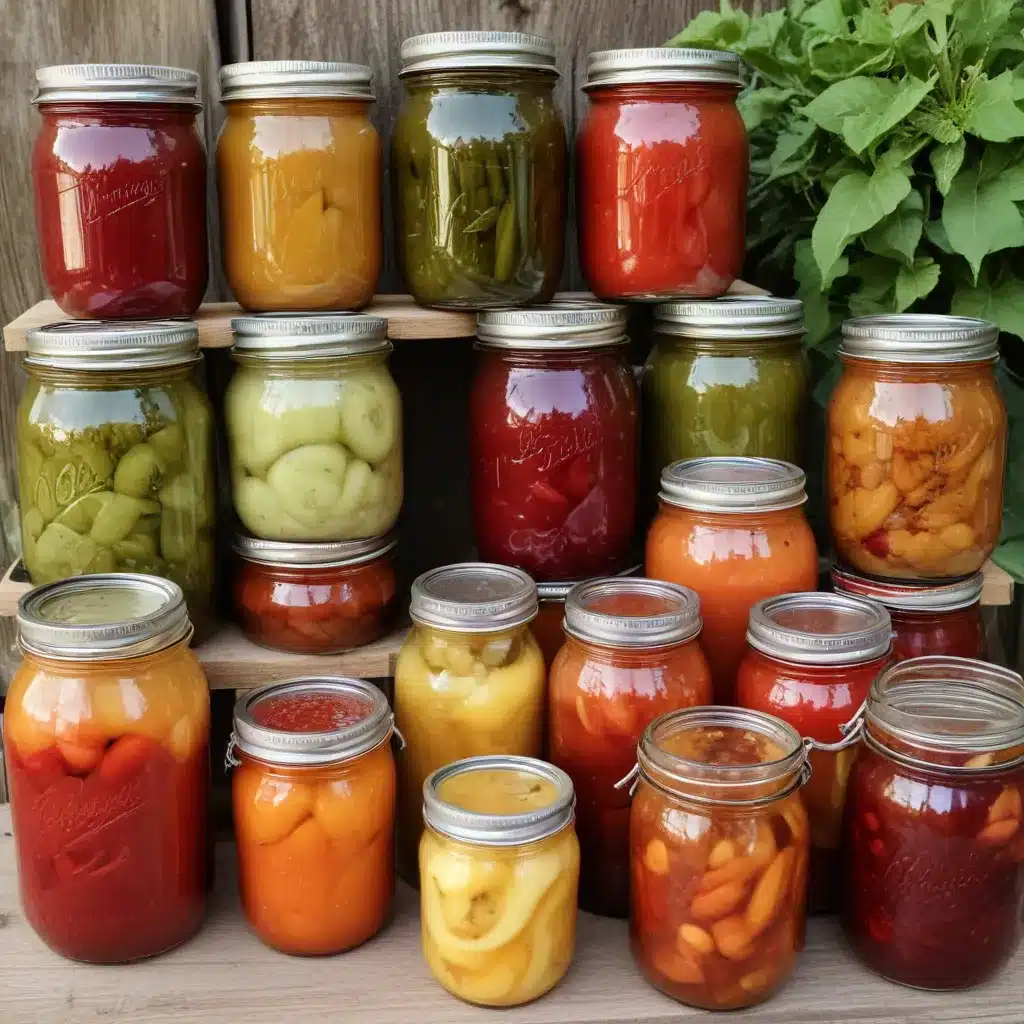
As the temperatures begin to cool and the summer garden harvest winds down, many of us at Crooked Pines Farm start turning our attention to preserving our bounty for the months ahead. While canning and fermentation may sound intimidating, they are time-honored techniques that can help you make the most of your garden’s abundance and enjoy the flavors of summer all year round.
Canning Fundamentals
Canning is a method of preserving food by sealing it in an airtight container. This process prevents the growth of microorganisms that could lead to spoilage, allowing your preserved foods to maintain their freshness for an extended period. There are two main types of canning: water bath canning and pressure canning.
Water bath canning is the simpler of the two, and is suitable for high-acid foods like fruits, jams, jellies, and pickles. The jars are submerged in a pot of boiling water, which kills any potential pathogens and creates a vacuum seal. Pressure canning, on the other hand, is used for low-acid foods like vegetables, meats, and soups. The jars are sealed and heated under pressure, which allows the temperature to reach higher levels and eliminate more resistant microorganisms.
When canning, it’s essential to follow tested recipes and safety guidelines to ensure your preserved foods are shelf-stable and safe to consume. Start by selecting the appropriate method based on the acidity of your ingredients, and be sure to use the proper canning equipment, such as a pressure canner or water bath canner, canning jars, and lids.
Fermentation Techniques
While canning is a tried-and-true preservation method, fermentation offers an equally compelling way to extend the life of your harvest. Fermentation harnesses the power of beneficial bacteria to transform the sugars and starches in fruits and vegetables into lactic acid, creating a tangy, probiotic-rich product.
The most common form of fermentation for home preservers is lacto-fermentation, which relies on the Lactobacillus bacteria naturally present on the surface of many plant foods. By creating an anaerobic (oxygen-free) environment and adding a brine of salt and water, you can encourage these beneficial bacteria to thrive, while inhibiting the growth of harmful microorganisms.
Lacto-fermented foods like sauerkraut, kimchi, and pickles are not only delicious, but also offer a wealth of health benefits. The fermentation process enhances the bioavailability of vitamins and minerals, and introduces a diverse array of gut-friendly probiotics.
To get started with fermentation, you’ll need a few basic tools, such as a non-reactive vessel (like a mason jar or fermentation crock), weights to keep your produce submerged in the brine, and an airlock or lid with a water seal to allow gases to escape. The key is to maintain the proper salt concentration (usually around 2-5% by weight) to create the ideal environment for your beneficial bacteria to thrive.
Food Safety Considerations
Whether you’re canning or fermenting, it’s crucial to follow food safety best practices to ensure the long-term viability and safety of your preserved foods. For canning, this means properly sterilizing your jars and lids, using the correct processing times and temperatures, and checking for any signs of spoilage before consuming.
With fermentation, the primary concern is preventing the growth of harmful bacteria, such as Clostridium botulinum, which can produce the deadly botulism toxin. By maintaining the proper salt levels, pH, and anaerobic conditions, you can create an environment that is inhospitable to these pathogens. Additionally, be sure to thoroughly clean and sterilize your fermentation vessels before use.
When in doubt, trust your senses. Give your preserved foods a thorough inspection before consuming, looking for any signs of off-odors, mold, or discoloration. If something seems amiss, it’s best to err on the side of caution and discard it.
Preserving Different Produce
The versatility of canning and fermentation allows you to preserve a wide variety of fruits, vegetables, herbs, and even meats and seafood. Some of the most common produce to preserve include:
Fruits and Berries: Jams, jellies, fruit syrups, and canned whole or sliced fruits are all excellent ways to capture the sweetness of summer’s bounty.
Vegetables: Tomatoes, peppers, carrots, and green beans are just a few of the veggies that lend themselves well to canning and fermentation. From pickled cucumbers to fermented sauerkraut, the possibilities are endless.
Herbs and Spices: Preserve the flavors of your herb garden by making herb-infused oils, vinegars, or dried herb blends. Fermented hot sauce is another great way to extend the life of your chili peppers.
Regardless of what you’re preserving, be sure to follow established recipes and safety guidelines to ensure your efforts are both delicious and safe.
Equipment and Supplies
Successful canning and fermentation requires a few key pieces of equipment. For canning, you’ll need a water bath or pressure canner, canning jars and lids, a jar lifter, and a magnetic lid wand. When fermenting, look for non-reactive vessels like glass jars or fermentation crocks, weights to keep your produce submerged, and airlock systems or specialized lids.
Additionally, consider investing in a digital kitchen scale to ensure you’re using the proper salt-to-vegetable ratio for your ferments, and a pH meter to monitor the acidity levels. With the right tools and a bit of practice, you’ll be well on your way to preserving your garden’s bounty for enjoyment all year round.
As the days grow shorter and the leaves begin to turn, take some time to explore the world of canning and fermentation. By mastering these time-honored preservation techniques, you can savor the flavors of summer for months to come, and share the abundance of your garden with family and friends. Happy preserving!


